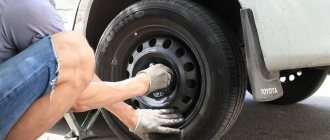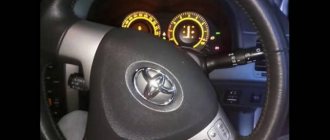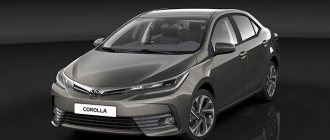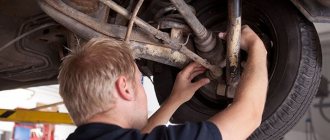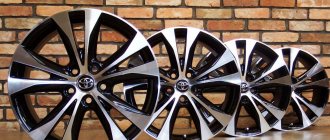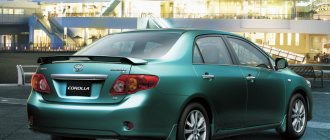What tires are suitable for Toyota Corolla?
Tire and wheel sizes for Toyota Corolla
| Engine | Year | Tires |
| 1.3 | 2000 | Factory equipment 165/70 R14 175/65 R14 195/55 R15 Replacement options 185/60 R14 185/65 R14 185/65 R15 195/60 R15 205/55 R15 205/50 R16 |
| 2001 | Factory equipment 165/70 R14 175/65 R14 185/65 R14 195/55 R15 Replacement options - | |
| 2001 | ||
| 2001 |
Recommendations for choosing disk sizes
Most production cars are equipped with factory wheels ranging in size from 13 to 17 inches. The standard wheel sizes for Toyota Corolla 120, depending on the year of manufacture and engine type, are 14,15,16 inches. Many owners seek to install larger wheels and tires in order to improve the driving performance of their car.
Without interfering with the chassis components, Toyota can be equipped with disks that are two to three times larger in size, depending on the model, year of manufacture and configuration. The disadvantage of such tuning is that the wheel becomes heavier if you use regular rubber of a standard profile: there will be more iron in the wheel, so the weight increases.
To balance the weight, low-profile tires and alloy wheels are used for tuning. In addition, the use of aluminum disks allows you to increase the mounting installation diameter without violating the permissible standards recommended by the manufacturer.
There are several rules for professional installation:
- The rim width should be 25% less than the tire profile size. For tire diameters up to R15, the permissible deviation in rim width is 0.5-1 inch, over R16 - from 1 to 1.5 inches. For example: to calculate the parameters of a wheel for a 180/60 R16 tire, you need to convert the tire width from millimeters to inches (1 inch = 25.4 mm). We get 180:25.4=7.68. From this figure we subtract 25%, round and derive the required rim width parameter - 5.5 inches. However, the best choice will always be an exact match between the wheel and tire sizes.
- The selection of the PCD (bolt pattern) parameter must always match to within a tenth of a millimeter. This applies to both the hub centering hole and the disc mounting bolts. A difference of even one millimeter leads to misalignment of the disk, damage to the fastenings (distortions) and leads to an emergency situation on the road.
- Selecting the ET value – wheel offset. Three types of offset are determined: zero (complete coincidence of the central axis of the disk and the hub mounting plane), negative (the disk axis is shifted inward relative to the hub) and positive (the disk axis is shifted outward relative to the hub). Proper installation always means zero offset, when the load on the chassis, disk and tire is distributed evenly. If the value is negative, an unwanted load may occur on the brake system and suspension components, which causes their incorrect operation and rapid wear. When positive, the load on the hub, bearing and shock absorber strut increases, which also leads to their rapid wear.
- Centering the wheel according to the mounting diameter (DIA). Most disks have a larger central mounting hole - this is allowed by the manufacturer if special mounting rings are used during installation, which are usually included in the installation kit. During this operation, they are guided by the PCD value: the size of the hub axis is adjusted to the size of the bore diameter.
- Availability and size of HUMP. Today, almost all modern tires on cars are tubeless. There are additional protrusions on the rim for fastening the tire beads, the size of which is indicated in the marking. The ideal choice would be one in which these values coincide to within a millimeter (tire and HUMP disk parameters).
- After installing larger rims and tires, the wheels are first checked with the vehicle jacked up and hanging. When turning the steering wheel all the way left and right, the edges of the tires should not touch the arches, and the disks should not come into contact with the suspension components and brake mechanisms. At the same time, pay attention to the presence of play. If these conditions are met, then the operation of the suspension is checked at low speed: forward movement with acceleration, full turn along a minimum radius in forward and reverse, emergency braking at speed.
- After all the conditions are met, the car with new wheels and tires must be checked on a computer wheel alignment stand, the wheel angles and their balancing are adjusted, and the mounting mounting rings are centered if necessary.
All replacement work should be carried out in a specialized car service center, which provides a guarantee for safe installation. The selection of wheels and tires for the Toyota Corolla 120 can be done using an online calculator, where you just need to enter the car make, year of manufacture, engine type or VIN.
What is the width of the rim for 205 tires?
Table of the dependence of the width of a passenger car tire on the landing width of the rim*
| Disc seat | Minimum tire width | Maximum tire width |
| 5.5 inches | 165 mm | 195 mm |
| 6.0 inches | 175 mm | 205 mm |
| 6.5 inches | 185 mm | 215 mm |
| 7.0 inches | 195 mm | 225 mm |
Installation parameters and disk sizes
Each car disk has its own markings - symbols and numbers indicate all the necessary installation parameters, bolt pattern and technical characteristics. Knowing the layout of a particular car or specifying these parameters in the operating manual, you can correctly select the required disk.
For example, the marking of a wheel on a Toyota Corolla E120 5*114.3 6J ET39 Dia54.1 R16 means: 5 mounting holes (drilling) with a diameter of 114.3 mm, a rim width of 6 inches, a rim offset of 39 mm, a rim diameter of 54.1 and a radius tires 16.
Disk size symbol scheme
D – landing diameter: the size of the maximum distance of the disk rim from the spot on which it rests to the top point. According to the international specification, it is always measured in inches.
B is the size on which the permissible installation width of the tire directly depends. This distance is the width between the extreme points of the mounting recesses of the disc rim. If the manufacturer provides for an upward error (maximum permissible no more than one inch), then it is indicated separately, which means: the tire size can be larger within certain limits. On low-profile tires, such errors are usually not allowed. Size B is also expressed in inches.
Schematic representation of the dimensions and parameters of the disk
ET is one of the most important parameters on which the location of the wheel relative to the vehicle arch, suspension components and braking system depends. This size (offset) is the distance from the central center line of the disk plane to the beginning of the hub attachment. Expressed in millimeters, its maximum permissible error (the possibility of setting a larger or smaller value) on the Toyota Corolla 120 is 5 mm. When installing a non-standard offset, try it on a suspended disk: the wheel should not catch the edges of the arch when turning or touch the suspension elements and interfere with the correct operation of the brake mechanisms. Experts do not recommend setting a smaller offset size, as provided by the manufacturer's recommendations: in this case, the car is guaranteed to be too sensitive to the steering rods, the braking force will not work correctly, and the directional stability indicator will decrease.
PCD – number of holes fastening to the hub, their sizes. The professional term bolt pattern defines the exact parameters of the holes and bolts installed at the factory, which must exactly match the corresponding markings on the new disk. The error here is unacceptable - the reliability of fastening the disk to the hub depends on this parameter. The bolt pattern on the Toyota Corolla 120 has one feature: for the American market, the chassis was supplied with dimensions at the hub of 5 * 100 mm, for the European market this value has always remained standard 5 * 114.3 mm.
Bolt pattern for Toyota Corolla
HUMP is a parameter for the size of additional protrusions on the rim, which serve as a fixation for tubeless tires. Measured in millimeters.
DIA is the mounting diameter of the size of the central hole for attaching the disk to the hub. Expressed in millimeters. This parameter cannot be adjusted downward. When you try to drill out the centering protrusion of the hub, the metal loses its load-resistance properties, the hub fails, and while driving, such consequences lead to an emergency situation (the wheel comes off while moving). Installation is only possible in the direction of a larger value; in this case, special mounting centering rings are used on the hub.
What is the Toyota Corolla 150 bolt pattern?
Disc drilling parameters are usually called bolt pattern:
| Make model modification Auto | Year of issue | Bolt pattern LZ*PCD |
| Toyota Corolla 1.6 VVT-i X (E150) | 2009 | 5X114.3 |
| Toyota Corolla 1.6 VVT-i X (E150) | 5X114.3 | |
| Toyota Corolla 1.6 VVT-i X (E150) | 5X114.3 | |
| Toyota Corolla 1.6 VVT-i X (E150) | 2008 | 5X114.3 |
THIS IS INTERESTING: What is the best way to lubricate the clutch pedal?
Modifications and their dimensions
Since the late 60s, when the Corolla first appeared in the sight of motorists, 11 generations of the car have already changed and the 12th is being produced. We, of course, will not go into the jungle of history, but will look at which wheels are suitable for the latest generations of Toyota Corolla.
2001-2006 (9th generation)
This version in the E120 body was officially presented in Frankfurt in 2001 - sedans and hatchbacks 3D and 5D. It was this generation that gained the greatest popularity, distinguishing this brand from other Toyota cars.
In Europe, it began to be sold in 2002 with gasoline engines (up to 1.8 l) and diesel engines (up to 2.2 l). And now, 17 years later, many cars of that generation are still in service.
| Modifications | What kind of wheel bolt pattern | Tire size | |||
| hub | basic | replacement options | base | replacement options | |
| 1.3 VVT-I; 1.5 VVT-I (NZE121); 2.2D (CE121) | 54,1 | 5.5Jx14 4/100 ET 39 | No options | 175/70 R14 | No options |
| 1.4 VVT-I; 1.6 VVT-I; 1.8 VVT-I; 1.8 VVTL-I; 2.0 D-4D (116 лс) | 54,1 | 5.5Jx14 4/100 ET 45 | 6Jx15 4/100 ET 45 6Jx16 4/100 ET 45 6Jx16 4/100 ET 45 7.5Jx17 4/100 ET 40 | 175/70 R14 | 195/60 R15 195/55 R16 205/55 R16 215/40 R17 |
| 1.5 VVT-I (NZE124); 1.8 VVT-I (ZZE122), | 54,1 | 6Jx14 4/100 ET 45 | No options | 185/70 R14 | No options |
| 1.8VTI | 54,1 | 6Jx15 5/100 ET 45 6Jx15 5/100 ET 45 | 6Jx16 5/100 ET 45 | 185/65 R15 195/65 R15 | 195/55 R16 |
| 2.0 D-4D (110 лс) | 54,1 | 5.5Jx14 4/100 ET 45 | 6Jx15 4/100 ET 45 6Jx16 4/100 ET 45 6Jx16 4/100 ET 45 | 175/70 R14 | 195/60 R15 195/55 R16 205/55 R16 |
2007-2012 (10th generation)
The next generation saw the Corolla line-up shrink as the hatchbacks were spun off into a separate model called the Auris.
There are sedans with various engine modifications and two design solutions for manual transmissions. They began to be sold in Russia in 2007.
| Modifications | Disk size | Tires for Toyota Corolla | |||
| hub | basic | replacement options | base | replacement options | |
| 1.33 VVT-I; 1.4 D-4D, 1.4 VVT-I [2007.. 2010] 5; 1.6 VVT-I (124 лс) [2007.. 2010] 5; 2.0 D-4D (126 лс) [2007.. 2009] 5 | 60,1 | 6Jx15 5/114.3 ET 39 | 6Jx15 5/114.3 ET 39 6.5Jx16 5/114.3 ET 45 7Jx17 5/114.3 ET 39 7Jx17 5/114.3 ET 45 | 195/65 R15 | 195/60 R15 205/55 R16 215/45 R17 225/45 R17 |
| 1.4 D; 1.4 VVT-I; 1.6 VVT-I (110 лс) [2004.. 2007] 4; 1.8 VVT-I; 1.8 VVTL-I; 2.0 D-4D (116 лс) | 54,1 | 5.5Jx14 4/100 ET 45 | 6Jx15 4/100 ET 45 6Jx16 4/100 ET 45 6Jx16 4/100 ET 45 7.5Jx17 4/100 ET 40 | 175/70 R14 | 195/60 R15 195/55 R16 205/55 R16 215/40 R17 |
| 1.8 VVTI, | 54,1 | 6Jx15 5/100 ET 45 6Jx15 5/100 ET 45 | 6Jx16 5/100 ET 45 | 185/65 R15 195/65 R15 | 195/55 R16 |
| 1.8 VVTL-I TS | 54,1 | 5.5Jx14 4/100 ET 45 | 6Jx15 4/100 ET 45 6Jx16 4/100 ET 45 7.5Jx17 4/100 ET 40 | 175/70 R14 | 195/60 R15 205/55 R16 215/40 R17 |
2013 – 2021 (11th generation)
By the summer of 2013, the eleventh version of the four-door Corolla was presented to the world. Let's see what has changed in terms of wheelbase:
| Modifications | Disk size | Tire parameters | |||
| hub | basic | replacement options | base | replacement options | |
| 1.33 VVT-I | 60,1 | 6Jx15 5/114.3 ET 39 6.5Jx16 5/114.3 ET 45 | 7Jx17 5/114.3 ET 50 | 195/65 R15 205/55 R16 | 215/45 R17 |
| 1.4 D-4D; 1.6; 1.8 VVT-I; 2.0 VVT-I | 60,1 | 6.5Jx16 5/114.3 ET 45 | 7Jx17 5/114.3 ET 50 | 205/55 R16 | 215/45 R17 |
| 1.6 VVT-I | 60,1 | 6.5Jx16 5/114.3 ET 45 | 6Jx15 5/114.3 ET 39 7Jx17 5/114.3 ET 50 | 205/55 R16 | 195/65 R15 215/45 R17 |
| 1.8I | 54,1 | 6Jx15 5/100 ET 33 6.5Jx16 5/100 ET 39 7Jx17 5/100 ET 39 | — | 195/65 R15 205/55 R16 215/45 R17 | — |
2018 onwards (12th generation)
The latest version of the Corolla was released at the 2018 New York Auto Show. There are no small cars in this generation at all, but there are only 2 engine modifications: 1.8 and 2.0 liters.
| Modifications | Disk size | Tire parameters | |||
| hub | basic | replacement options | base | replacement options | |
| 1.8I | 54,1 | 6Jx15 5/100 ET 33 6.5Jx16 5/100 ET 39 7Jx17 5/100 ET 39 | — | 195/65 R15 205/55 R16 215/45 R17 | — |
| 2.0I | 54,1 | 7Jx16 5/100 ET 40 8Jx18 5/100 ET 40 | 6.5Jx15 5/100 ET 40 | 205/55 R16 225/40 R18 | 195/65 R15 |
Recommendations for bolt removal
This parameter can be measured in several ways. To make the work easier, professionals have created special tables that indicate basic information about each model. It rarely happens that you have to calculate the parameters yourself. A similar figure from Toyota typically includes PCD components with two numbers separated by a fraction.
READ NEXT: Replacing Toyota Corolla stabilizer bushings
Here is a special table:
The number of bolts that hold the wheel is indicated in the table by the first number, but it is also not difficult to count them yourself. The second number refers to the diameter of the circle for Toyota retaining bolts. This indicator can be determined using the appropriate formula. We measure the distance between two bolts located parallel to each other, and then multiply this indicator by a constant.
Depending on how many bots are involved in fastening the disk: with three holes - 1.155, with four - 1.701. An auxiliary tool in this work can be a caliper. The resulting value will be considered the second digit in the bolt pattern indicator of these elements of a Toyota car.
Discs for this model are also often changed in order to improve external performance and driving characteristics. In such a situation, the factory Corolla parts are removed. In their place, non-original elements are installed, which may have a unique design.
Toyota bolt patterns must be carefully checked to prevent the mechanisms from loosening while driving.
If certain parts do not match your vehicle's specifications, it is best not to install them. And try to choose others so as not to cause damage to your car. To make your Toyota look beautiful without compromising its safety characteristics, you need to pay special attention to the bolt pattern.
As already mentioned, Toyota bolt patterns should be handled by real professionals. They must have the appropriate qualifications so that the work done does not have to be redone later. Before starting work, they can also look at the parameters and advise which drives are best to use in a given situation. You will be protected by a guarantee.
Wheel rim bolt pattern
The most competent decision would be to choose original wheels for Toyota Corolla.
You need to understand why exactly such rollers are optimal and non-destructive for suspension. In this case, it is necessary to understand such a concept as wheel rim bolt pattern.
The manual for the Toyota Corolla states what this notorious bolt pattern should be. It clearly states that in cars produced from 1999 to 2001 this parameter is 4x100 mm, and in subsequent years it became 5x100 mm. In fact, this means that the diameter of the circle on which the holes for the bolts (studs) are located is 100 mm, and the number of these bolts is four, and for later models - 5 bolts.
The bolt pattern is designated PCD and is calculated as follows: the distance between adjacent holes for studs (bolts) is measured with a caliper and the result is multiplied by a factor of 1.701 - we obtain the bolt pattern of the existing roller. This parameter is needed so that a custom roller can be drilled, which has a smaller offset and a larger diameter, and wider tires are installed on it.
Tire differences depending on season
Nowadays, almost no one has any questions regarding the mandatory change of tires depending on the time of year. Of course, summer and winter tires differ not only in studs. Summer tires provide maximum grip on both dry and wet asphalt and are more suitable for high-speed driving.
The advantage of winter tires is their adaptability to road conditions and the change in road grip depending on them. Winter tires are more flexible, so when driving on bare asphalt, they will wear out more than summer tires.

